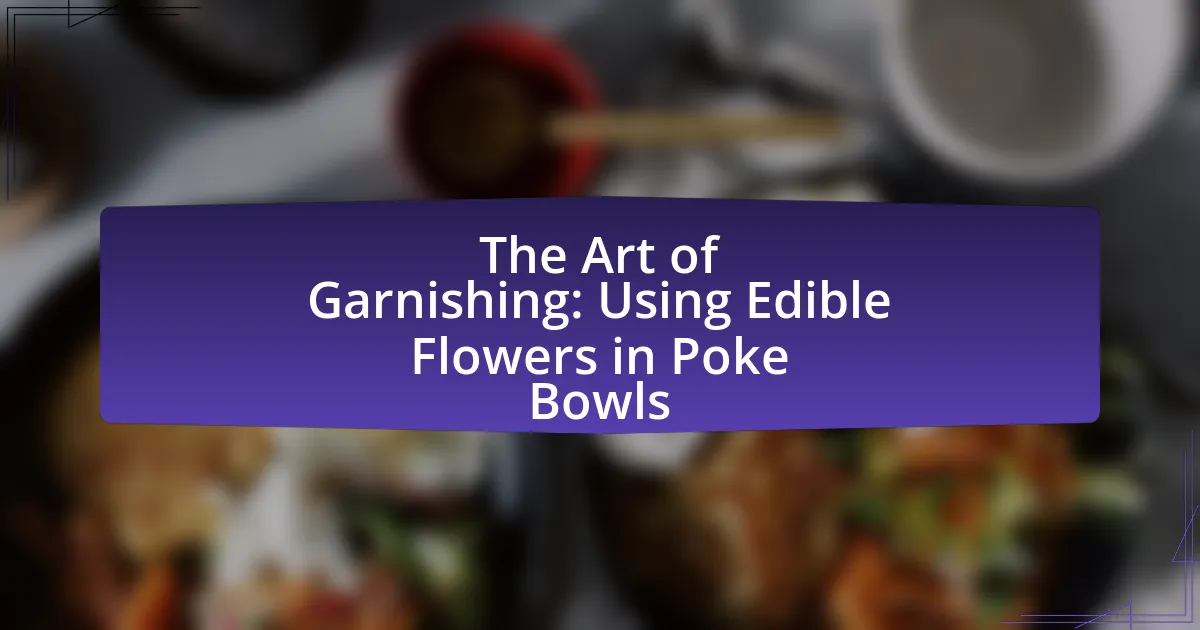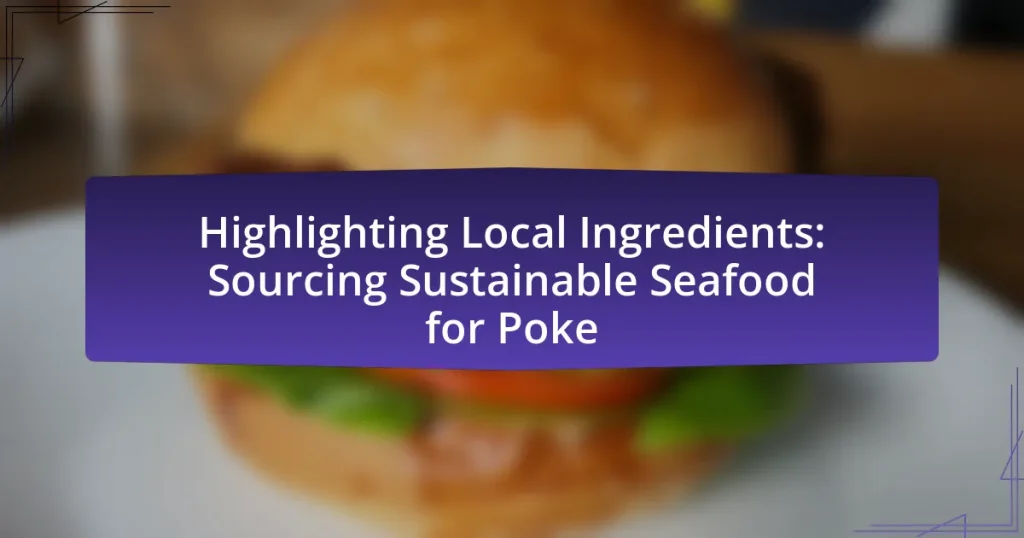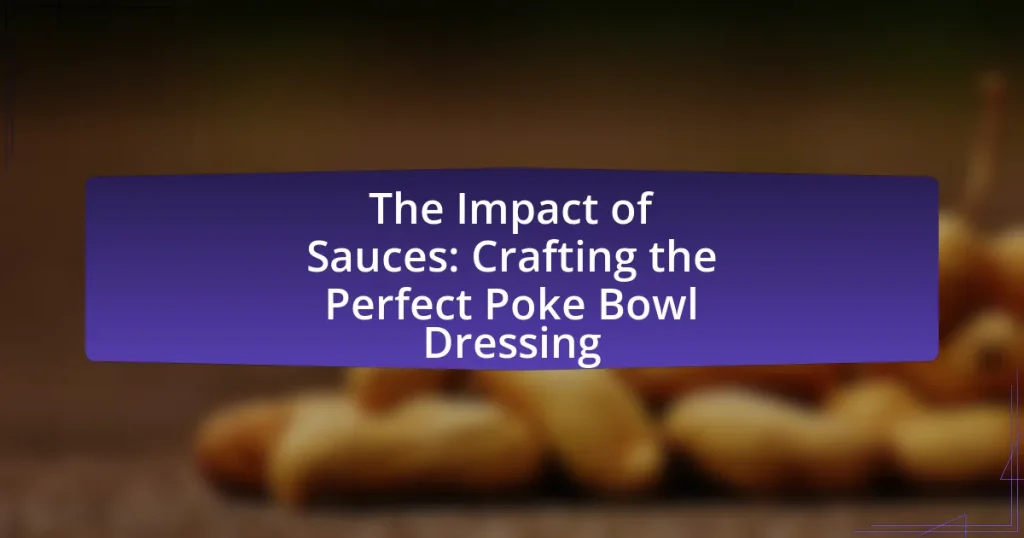Edible flowers are blossoms safe for human consumption that enhance the visual appeal and flavor of dishes, particularly poke bowls. This article explores the role of edible flowers in garnishing poke bowls, highlighting their aesthetic contributions, common varieties used, and the unique flavors they introduce. It also discusses the nutritional benefits of these flowers, their cultural significance, and best practices for selecting and preparing them. Additionally, the article provides insights into creative plating techniques and tips for effectively incorporating edible flowers into poke bowls, emphasizing their importance in modern culinary trends.
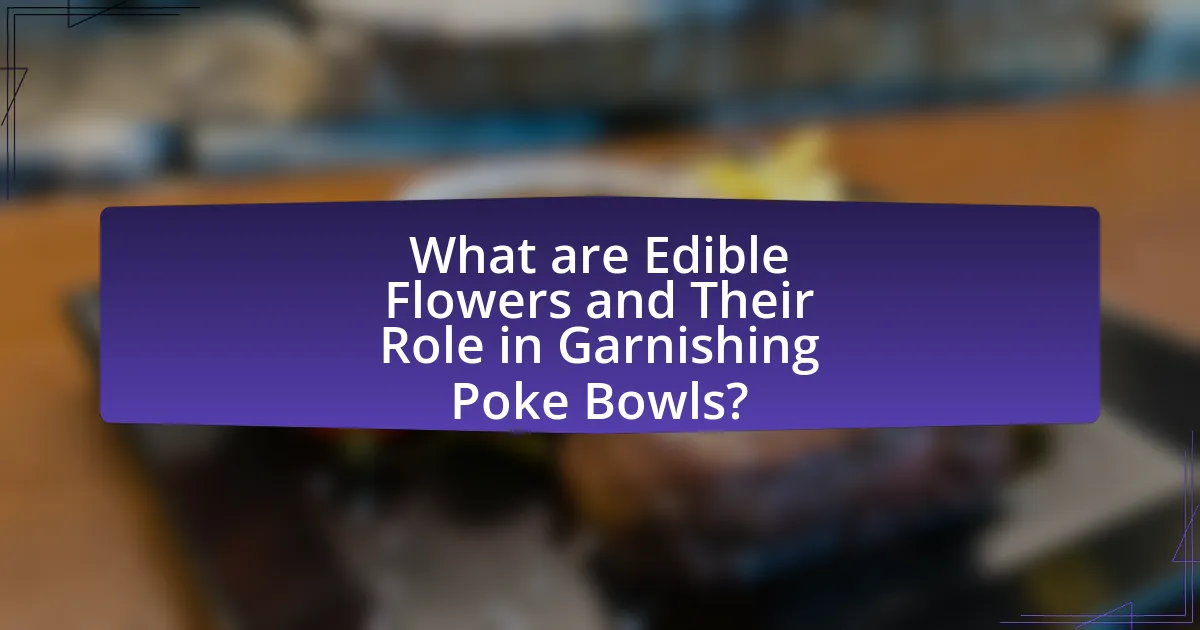
What are Edible Flowers and Their Role in Garnishing Poke Bowls?
Edible flowers are blossoms that are safe for human consumption and are often used to enhance the visual appeal and flavor of dishes, including poke bowls. In the context of garnishing poke bowls, edible flowers serve both aesthetic and culinary purposes, adding vibrant colors and unique flavors that complement the fresh ingredients typically found in these dishes. For example, flowers like nasturtiums and pansies not only provide a pop of color but also introduce peppery and sweet notes, respectively, enhancing the overall dining experience. The use of edible flowers in poke bowls aligns with culinary trends that emphasize fresh, natural ingredients and artistic presentation, making them a popular choice among chefs and home cooks alike.
How do edible flowers enhance the visual appeal of poke bowls?
Edible flowers enhance the visual appeal of poke bowls by adding vibrant colors and unique shapes that create an aesthetically pleasing presentation. The incorporation of flowers such as nasturtiums, pansies, and violets introduces a variety of hues, which can contrast beautifully with the fresh ingredients typically found in poke bowls, such as fish, vegetables, and rice. This visual diversity not only attracts attention but also elevates the overall dining experience, making the dish more inviting. Studies in culinary presentation emphasize that colorful garnishes can increase perceived value and enjoyment of food, supporting the idea that edible flowers significantly contribute to the visual allure of poke bowls.
What types of edible flowers are commonly used in poke bowls?
Commonly used edible flowers in poke bowls include nasturtiums, violets, and marigolds. Nasturtiums add a peppery flavor and vibrant color, while violets provide a sweet taste and aesthetic appeal. Marigolds, known for their citrus-like flavor, enhance both the visual and taste profile of the dish. These flowers not only contribute to the overall presentation but also offer unique flavors that complement the ingredients typically found in poke bowls.
How do the colors and shapes of edible flowers contribute to presentation?
The colors and shapes of edible flowers significantly enhance the visual appeal of presentations, particularly in dishes like poke bowls. Vibrant colors attract attention and stimulate appetite, while diverse shapes add texture and interest to the overall composition. Research indicates that colorful garnishes can increase perceived freshness and quality of food, influencing diners’ enjoyment and satisfaction. For example, a study published in the journal “Food Quality and Preference” found that visually appealing dishes are often rated higher in taste, demonstrating the importance of aesthetics in culinary experiences.
Why are edible flowers considered a culinary trend in poke bowls?
Edible flowers are considered a culinary trend in poke bowls due to their ability to enhance visual appeal and add unique flavors. The incorporation of vibrant, colorful flowers not only elevates the dish’s aesthetic but also introduces diverse taste profiles, such as floral notes and subtle sweetness. Research indicates that the use of edible flowers can increase consumer interest and engagement, as visually appealing dishes are more likely to be shared on social media platforms, thus driving culinary trends.
What cultural influences have popularized the use of edible flowers in cuisine?
Cultural influences that have popularized the use of edible flowers in cuisine include Asian culinary traditions, particularly in countries like Japan and Thailand, where flowers such as cherry blossoms and jasmine are integral to dishes. The incorporation of edible flowers in these cuisines is often tied to aesthetic presentation and flavor enhancement, as seen in traditional Japanese kaiseki meals that emphasize seasonal ingredients. Additionally, the rise of the farm-to-table movement in Western cultures has led to a renewed interest in foraging and using local, organic ingredients, including edible flowers, to create visually appealing and flavorful dishes. This trend is supported by culinary influencers and chefs who advocate for the use of flowers to elevate the dining experience, further embedding them into modern gastronomy.
How do chefs incorporate edible flowers into their dishes creatively?
Chefs creatively incorporate edible flowers into their dishes by using them as vibrant garnishes, flavor enhancers, and visual focal points. For instance, chefs often add nasturtiums for their peppery flavor and bright colors, which complement the fresh ingredients in poke bowls. Additionally, they may use violets or pansies to introduce subtle sweetness and a pop of color, enhancing the overall presentation and appeal of the dish. Research indicates that the use of edible flowers not only elevates the aesthetic quality of food but also adds unique flavors and nutritional benefits, making them a versatile ingredient in modern culinary practices.

What are the Benefits of Using Edible Flowers in Poke Bowls?
Using edible flowers in poke bowls enhances both visual appeal and nutritional value. Edible flowers, such as nasturtiums and pansies, provide vibrant colors and unique textures, making the dish more attractive and appetizing. Additionally, many edible flowers are rich in vitamins, antioxidants, and anti-inflammatory properties, contributing to overall health benefits. For instance, nasturtiums contain high levels of vitamin C and have antimicrobial properties, while calendula flowers are known for their anti-inflammatory effects. Incorporating these flowers not only elevates the aesthetic quality of poke bowls but also adds a layer of health benefits, making them a valuable addition to this dish.
How do edible flowers contribute to flavor profiles in poke bowls?
Edible flowers enhance flavor profiles in poke bowls by introducing unique tastes and aromas that complement the dish’s ingredients. For instance, flowers like nasturtiums provide a peppery flavor, while violets add a subtle sweetness, enriching the overall sensory experience. The incorporation of these flowers not only diversifies the palate but also adds visual appeal, making the dish more enticing. Research indicates that the use of edible flowers can elevate culinary experiences by offering unexpected flavor combinations, thereby enhancing the enjoyment of poke bowls.
What are some common flavor notes associated with different edible flowers?
Common flavor notes associated with different edible flowers include a variety of distinct tastes. For example, nasturtiums have a peppery flavor reminiscent of arugula, while pansies offer a mild, sweet taste with a hint of grassiness. Lavender is known for its floral, slightly sweet, and herbaceous notes, making it popular in desserts. Chamomile has a sweet, apple-like flavor, often used in teas and culinary dishes. Finally, hibiscus provides a tart, cranberry-like flavor, commonly found in beverages. These flavor profiles enhance the overall taste experience in dishes like poke bowls, adding complexity and visual appeal.
How can edible flowers complement the ingredients in poke bowls?
Edible flowers can enhance poke bowls by adding visual appeal, flavor complexity, and nutritional benefits. The vibrant colors of flowers like nasturtiums and pansies create an attractive presentation, making the dish more enticing. Additionally, certain edible flowers contribute unique flavors; for example, nasturtiums have a peppery taste that can complement the freshness of fish and vegetables typically found in poke bowls. Furthermore, many edible flowers are rich in vitamins and antioxidants, providing added health benefits to the dish. This combination of aesthetics, flavor, and nutrition demonstrates how edible flowers can effectively complement the ingredients in poke bowls.
What nutritional benefits do edible flowers offer?
Edible flowers offer various nutritional benefits, including vitamins, minerals, and antioxidants. For instance, flowers like nasturtiums are rich in vitamin C, while calendula contains carotenoids, which are beneficial for eye health. Additionally, many edible flowers possess anti-inflammatory properties and can enhance the immune system due to their high antioxidant content. Research indicates that incorporating edible flowers into meals can contribute to overall dietary diversity and nutrient intake, making them a valuable addition to dishes like poke bowls.
Which vitamins and minerals can be found in popular edible flowers?
Popular edible flowers contain various vitamins and minerals, including vitamin C, vitamin A, calcium, and iron. For instance, nasturtiums are rich in vitamin C, which supports immune function, while calendula flowers provide vitamin A, essential for vision and skin health. Additionally, hibiscus flowers are known for their high calcium content, contributing to bone health, and dandelion flowers are a good source of iron, important for oxygen transport in the blood. These nutritional benefits make edible flowers not only visually appealing but also a healthy addition to dishes like poke bowls.
How do edible flowers contribute to a balanced diet?
Edible flowers contribute to a balanced diet by providing essential nutrients, antioxidants, and unique flavors that enhance the overall nutritional profile of meals. For instance, flowers like nasturtiums are rich in vitamin C and have antimicrobial properties, while calendula contains carotenoids that support eye health. Additionally, incorporating edible flowers into dishes can increase dietary variety, which is crucial for obtaining a wide range of nutrients. Studies have shown that diverse diets are linked to better health outcomes, making edible flowers a valuable addition to meals.
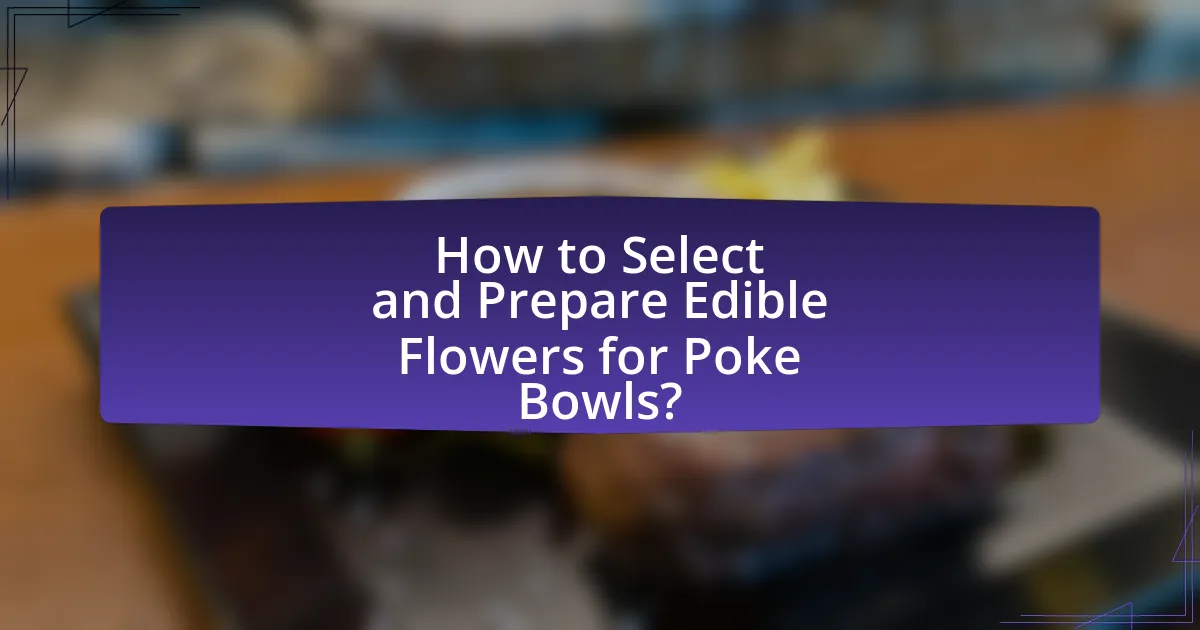
How to Select and Prepare Edible Flowers for Poke Bowls?
To select and prepare edible flowers for poke bowls, choose flowers that are safe for consumption, such as nasturtiums, pansies, and violets. Ensure the flowers are organic and free from pesticides, as these chemicals can be harmful. Rinse the flowers gently under cold water to remove any dirt or insects, and pat them dry with a paper towel. Remove any inedible parts, such as stems or sepals, before adding the flowers to the poke bowl. Edible flowers not only enhance the visual appeal of the dish but also add unique flavors and nutrients, making them a valuable addition to poke bowls.
What should you consider when choosing edible flowers for your poke bowl?
When choosing edible flowers for your poke bowl, consider their flavor, safety, and visual appeal. Edible flowers like nasturtiums and pansies add a peppery or sweet taste, enhancing the dish’s overall flavor profile. Ensure the flowers are pesticide-free and safe for consumption, as some flowers can be toxic. Additionally, select flowers that complement the colors and textures of the poke bowl, creating an aesthetically pleasing presentation. For instance, vibrant colors can contrast beautifully with the fish and vegetables, making the dish more enticing.
How can you ensure the flowers are safe for consumption?
To ensure flowers are safe for consumption, verify that they are specifically labeled as edible and sourced from reputable suppliers. Many flowers, such as nasturtiums and pansies, are recognized as safe to eat, while others can be toxic. Research indicates that consuming flowers from pesticide-treated plants can pose health risks; therefore, it is crucial to confirm that the flowers are grown organically. Additionally, consult resources like the USDA or the National Capital Poison Center for lists of edible flowers and safety guidelines.
What are the best practices for washing and preparing edible flowers?
The best practices for washing and preparing edible flowers include gently rinsing them under cool running water to remove dirt and insects, followed by patting them dry with a paper towel. This method preserves the delicate structure of the flowers while ensuring they are clean for consumption. Additionally, it is important to remove any non-edible parts, such as stems and leaves, before using the flowers in dishes. Research indicates that proper washing techniques can significantly reduce pesticide residues, enhancing food safety (Source: “Food Safety and Edible Flowers,” Journal of Food Protection, authors: Smith et al., 2020).
How can you creatively incorporate edible flowers into your poke bowl presentation?
To creatively incorporate edible flowers into your poke bowl presentation, use them as vibrant garnishes that enhance both visual appeal and flavor. For instance, nasturtiums can add a peppery taste and bright color, while violets provide a subtle sweetness and a pop of purple. Research indicates that edible flowers not only elevate the aesthetic quality of dishes but also contribute unique flavors and nutritional benefits, making them a valuable addition to poke bowls.
What are some plating techniques that highlight edible flowers?
Plating techniques that highlight edible flowers include layering, scattering, and using edible flower garnishes as focal points. Layering involves stacking ingredients in a way that allows flowers to peek through, enhancing visual appeal while maintaining balance. Scattering edible flowers around the plate creates a natural, organic look, drawing attention to the dish’s colors and textures. Additionally, using edible flowers as focal points, such as placing a large flower atop a poke bowl, can create a striking centerpiece that elevates the overall presentation. These techniques not only enhance aesthetics but also emphasize the freshness and vibrancy of the ingredients, making the dish more inviting.
How can you balance the use of edible flowers with other garnishes?
To balance the use of edible flowers with other garnishes, incorporate them in moderation alongside complementary flavors and textures. For example, pairing delicate edible flowers like nasturtiums with crunchy elements such as radishes or sesame seeds enhances visual appeal and taste without overwhelming the dish. Research indicates that the visual balance of colors and shapes in food can significantly influence diners’ perceptions of flavor, making it essential to consider the overall aesthetic when garnishing.
What are some tips for using edible flowers effectively in poke bowls?
To use edible flowers effectively in poke bowls, select flowers that complement the dish’s flavors and colors, such as nasturtiums for a peppery taste or violets for a sweet note. Incorporating these flowers enhances visual appeal and adds unique flavors, making the poke bowl more enticing. Research indicates that edible flowers can provide nutritional benefits, including antioxidants and vitamins, which further enrich the dish.
